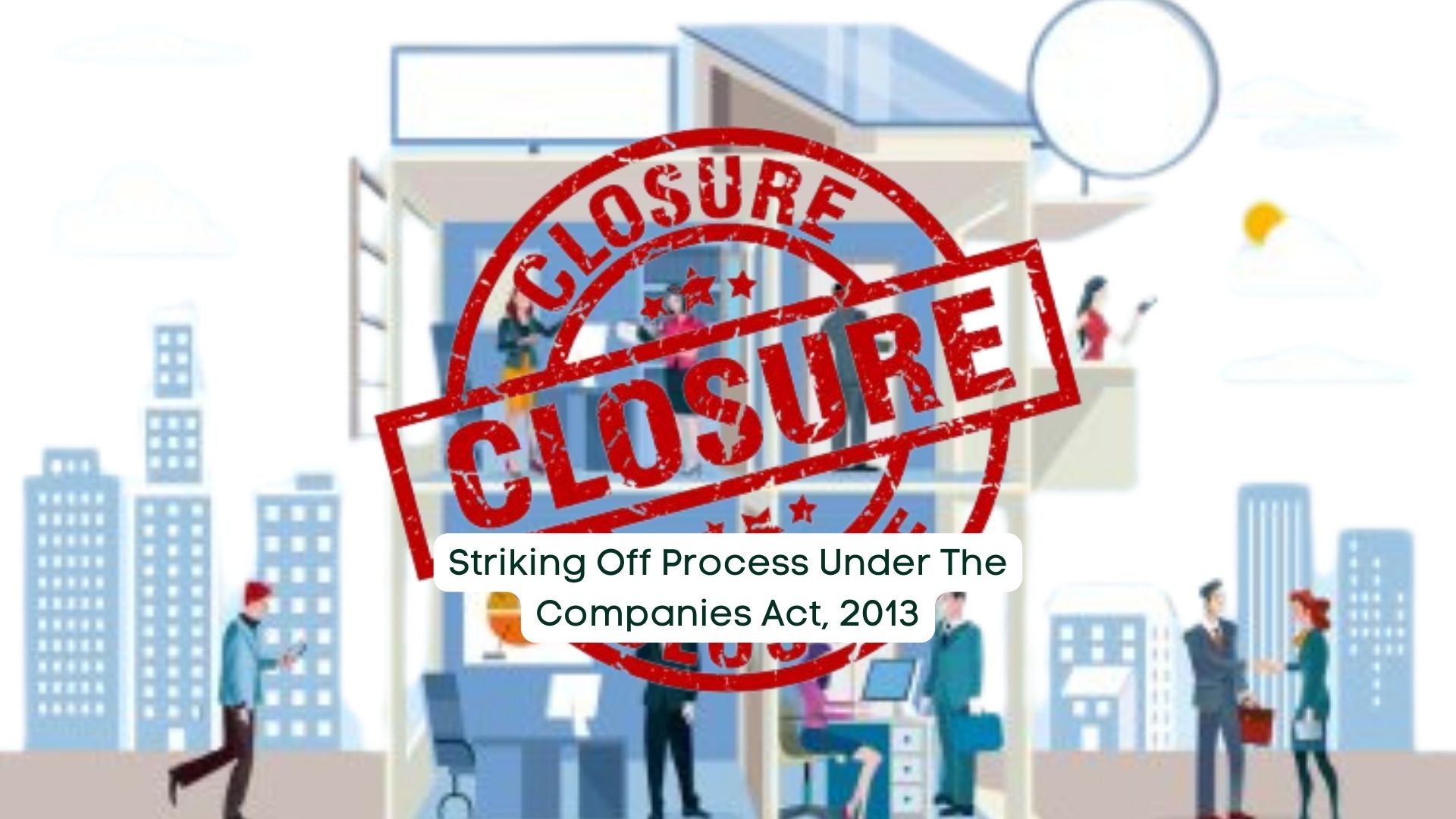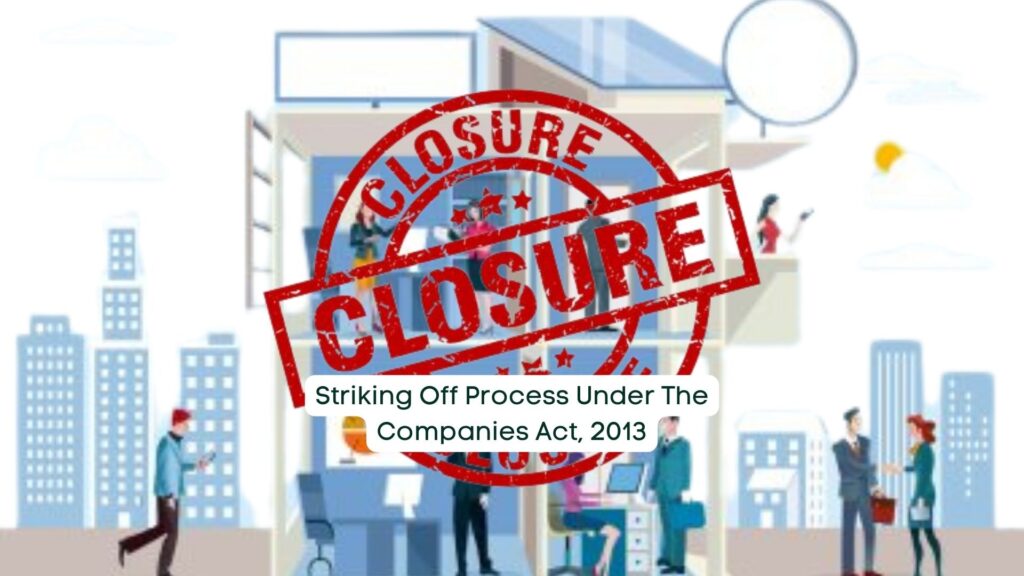
26 Feb Striking off Process under the Companies Act, 2013

Operating a company is never easy, and sometimes tough decisions to shut down a company become inevitable for its founders. Over the past three years, approximately 3.8 lakh companies have been struck off under the Companies Act, 2013. When it comes to closing a company, there are two primary methods: striking off and winding up. Additionally, some businesses choose termination and removal of their name from the Registrar of Companies (ROC) as a feasible option. The process of striking off under the Companies Act, 2013 is governed by section 248.
This article delves into the procedure of striking off companies under section 248, outlining the process under the Companies Act, 2013, and the necessary documentation for strike off.
Concept of Strike Off
In simple terms, striking off entails removing a company’s name from the Register of Companies. The process under the Companies Act, 2013 resembles the closure or winding up of a company. Once struck off, the company ceases to exist and cannot operate thereafter.
Legal Framework for Striking off under Companies Act, 2013
Section 248 of the Companies Act grants authority to the Registrar to remove a company’s name from the ROC. This section empowers the Registrar to eliminate a company’s name under certain circumstances. Firstly, if the company fails to commence business within one year of incorporation. Secondly, if the company fails to conduct business for two consecutive financial years and hasn’t applied for dormant company status under section 455 of the Companies Act, 2013.
A dormant company is one that remains inactive, with no accounting transactions, despite being registered under the Companies Act.
Furthermore, Section 248(2) allows a company, by special resolution, to apply for the removal of its name from the ROC.
Companies must also adhere to the Companies (Removal of Names of Companies from the Register of Companies) Rules, 2016 for the striking off process under the Companies Act, 2013.
Amendment to Rule 4 of the Companies (Removal of Names of Companies from the Register of Companies) Rules, 2016
Before the 2019 Amendment, companies could file a strike-off application using Form STK-2 only after submitting overdue returns such as AOC-4 or AOC-4 XBRL along with Form MGT-7. However, there were instances where the ROC accepted strike-off applications without the overdue returns, leading to discrepancies. The 2019 amendment brought clarity to this process.
Following the amendment in May 2019, Rule 4 of the Companies (Removal of Names of Companies from the Register of Companies) Rules, 2016 stipulates that companies cannot file Form STK-2 unless they have submitted overdue returns such as AOC-4 or AOC-4 CBRL and Form MGT-7 up to the end of the financial year. AOC-4 represents the financial statement, while MGT-7 is the annual return of the company.
Therefore, companies must file the annual return for the years in which they conducted business. Filing pending annual returns before striking off is not mandatory; companies can proceed without filing annual returns for inactive years.
Additionally, the Ministry increased the striking off application fees to Rs. 10,000, a move criticized for doubling the exit fee while reducing the incorporation fee to zero.
Procedure for Striking off under Companies Act, 2013
Striking off a company in India under the Companies Act can occur through two methods:
- Strike-off by the Registrar of the Company under section 248(1): The Registrar has the authority to strike off a company from the register of companies, either suo-moto or upon receiving an application. The Registrar issues a notice to the company via Form STK-1, informing them of the name's removal from the ROC. This process is also known as compulsory removal. Grounds for striking off include failure to commence business within one year of incorporation and failure to conduct business for two consecutive financial years without applying for dormant company status.
- Striking off Company under Section 248(2): Companies can initiate the striking off process themselves by filing an application using Form STK-2 after settling their liabilities. This can be done if they have not commenced business or have remained inactive for the past two financial years. The process involves passing a special resolution with the consent of 75% of the members.
Procedure Followed by ROC under section 248(1)
The ROC follows a specific process for striking off under the Companies Act:
- The Registrar sends a notice to the company via Form STK-1, notifying them of the name's withdrawal from the ROC.
- The ROC reviews any representations made by the company. If unsatisfied, it proceeds accordingly.
- The notice is published on the official MCA website, in the official gazette, and in newspapers in English and a vernacular language.
- Regulatory authorities with jurisdiction are also notified, allowing them to raise objections or issues within 30 days.
- Upon the expiry of the specified time, the ROC strikes off the name and publishes the notice in the Official Gazette. The company stands dissolved upon publication.
Before striking off, the Registrar ensures the company has settled all liabilities and payments.
Process of Strike-off by Registrar of the Company under section 248(2)
The company convenes a board meeting to pass a resolution, initiating the striking off process. Subsequently, they settle all liabilities and hold a general meeting of shareholders, passing a resolution with the consent of 75% of the members. Form MGT-14 must be filed within 30 days.
Documents Required for Strike off
Companies must submit the following documents with their strike-off application under the Companies Act:
- A duly notarized Indemnity bond in Form STK-3.
- Statement of liabilities or accounts, comprising the company's assets and liabilities, in Form STK-8.
- An affidavit in Form STK 4.
- A copy of the Special Resolution signed by the directors.
- A statement regarding any pending litigations involving the company.
After-Effects of Dissolution
Under section 250 of the Companies Act, if a company dissolves under section 248, it must cease operations immediately as per the notice of dissolution. The certificate of incorporation is also canceled.
Liabilities of directors to continue
The obligations of the directors and other officers persist even after dissolution and can be enforced as if the company were still operational.
Prohibited Companies from Striking off
Section 249 of the Act prohibits certain companies from applying under section 248(2), including those that have changed their name, shifted registered offices across states, disposed of property, engaged in non-essential activities within the past three months, or applied for a compromise or arrangement that is pending decision. Additionally, companies under winding up proceedings cannot apply.
Consequences of Non-Compliance with Companies Act
Failure to comply with Section 455 of the Act and Companies (Miscellaneous) Rules, 2014, such as not filing annual returns within 30 days of the financial year ending, results in the ROC striking off the company’s name. Section 450 imposes penalties for non-compliance, affecting both the company and its directors.
Conclusion
Striking off under the Companies Act, 2013 provides a practical option for companies seeking closure. It simplifies the process of ending a company’s operations and can be initiated by either the company or the ROC. This provision aims to facilitate ease of doing business and streamline closure procedures.


No Comments